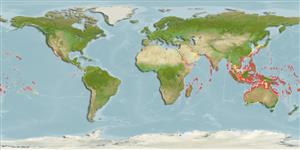Environment: milieu / climate zone / depth range / distribution range
Ecologie
marien rifbewoner; diepte 2 - 40 m (Ref. 48637), usually 10 - ? m. Tropical
Indo-Pacific: East Africa to Micronesia (excluding the Marshall Islands), north to the Ryukyu Islands, south to the Solomon Islands and the Great Barrier Reef. Range extending to Rangiroa Atoll, Tuamotu Archipelago.
Grootte / Gewicht / Leeftijd
Maturity: Lm ? range ? - ? cm
Max length : 40.0 cm FL mannelijk / geslacht onbekend; (Ref. 9710); common length : 25.0 cm FL mannelijk / geslacht onbekend; (Ref. 9710)
Dorsale stekels (totaal) : 4; Dorsale zachte stralen (totaal) : 28 - 30; Anale stekels: 2; Anale zachte stralen: 27 - 29. Body elongate-ovate. Dorsal and anal profiles nearly even. Forehead without rostral prominence when in adults. Peduncular plate single, with a semicircular, retrorsely curved keel. Reaches 35 cm SL.
Generally uncommon species found in steep outer lagoon and seaward reef slopes (Ref. 9710, 48637). Maximum depth reported at 40m (Ref. 37792) Occurs singly or in large schools (Ref. 9710, 48637). Usually seen swimming steadily along upper edges of drop-offs in pursuit of plankton (Ref. 48637). A semi-pelagic fish that feeds on zooplankton, but remains over or near reefs. Also feeds on algae (Ref. 30573). It is cleaned by Labroides and sleeps on reefs at night, taking on a disruptive mottled pattern (Ref. 10671). Caught with nets (Ref. 30573).
Levenscyclus en paargedrag
Maturities | Voortplanting | Spawnings | Egg(s) | Fecundities | Larven
Randall, J.E., 1994. Unicornfishes of the subgenus Axinurus Perciformes: Acanthuridae: Naso), with description of a new species. Copeia 1994(1):116-124. (Ref. 10671)
Status op de Rode Lijst van het IUCN (Ref. 130435)
Gevaar voor de mens
Harmless
Gebruik door de mens
Visserij: commercieel; Aquarium: Commercieel
Tools
Speciale rapporten
Download XML
Internetbronnen
Estimates based on models
Preferred temperature (Ref.
123201): 24.7 - 29, mean 27.7 °C (based on 470 cells).
Fylogenetische diversiteitsindex (Ref.
82804): PD
50 = 0.5000 [Uniqueness, from 0.5 = low to 2.0 = high].
Bayesian length-weight: a=0.01950 (0.01114 - 0.03412), b=3.09 (2.94 - 3.24), in cm total length, based on LWR estimates for this species & Genus-body shape (Ref.
93245).
Trofisch niveau (Ref.
69278): 3.0 ±0.32 se; based on food items.
Weerstandsvermogen (Ref.
120179): Gemiddeld, minimale populatieverdubbelingstijd 1,4-4,4 jaar (Preliminary K or Fecundity.).
Fishing Vulnerability (Ref.
59153): Low to moderate vulnerability (34 of 100).
Nutrients (Ref.
124155): Calcium = 42.7 [26.3, 73.0] mg/100g; Iron = 0.552 [0.287, 0.947] mg/100g; Protein = 19 [18, 20] %; Omega3 = 0.139 [0.094, 0.248] g/100g; Selenium = 31 [18, 49] μg/100g; VitaminA = 70.4 [28.1, 175.2] μg/100g; Zinc = 1.3 [0.9, 1.8] mg/100g (wet weight);
